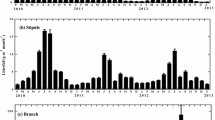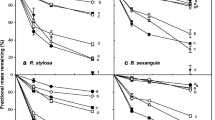Abstract
This study was conducted to evaluate and compare the litterfall dynamics of three mangrove species in the family Rhizophoraceae: Rhizophora stylosa, Kandelia obovata, and Bruguiera gymnorrhiza, in Manko Wetland, Okinawa Island, Japan. Over 3 years, these species showed highest litterfall of leaves and stipules in summer and the lowest litterfall in winter. Litterfall of flowers and fruits peaked in July for R. stylosa, and in August and again in October–November for K. obovata. Litterfall of flower buds, flowers, and propagules occurred throughout the year for B. gymnorrhiza, but was highest in summer. Litterfall of propagules was highest in September and May for R. stylosa and K. obovata, respectively. Kendall’s coefficient of concordance revealed that the monthly changes for leaf, stipule, flower, and fruit litterfalls of all the species were strongly and significantly concordant among the years. The conversion rate of flowers to propagules was 2.3 % in R. stylosa, 5.9 % in K. obovata, and 10.3 % in B. gymnorrhiza. Total annual litterfall in R. stylosa was significantly different from K. obovata and B. gymnorrhiza; however, the latter two species showed no significant differences. Leaves contributed the most to the total litterfall of all three species, and represented 58.4, 54.0, and 50.4 % of the total litterfall for R. stylosa, K. obovata, and B. gymnorrhiza, respectively. Except for branches and flower bud primordia, all other components of litterfall had clear annual cycles for all three species. Rhizophora stylosa and K. obovata showed a negative correlation between leaf production and reproductive organ production, but B. gymnorrhiza tended to increase leaf production with increasing reproductive organ production.



Similar content being viewed by others
References
Allen JA, Duke NC (2006) Bruguiera gymnorrhiza (large-leafed mangrove), ver. 2.1. In: Elevitch CR (ed) Species profiles for pacific island agroforestry. Permanent Agriculture Resources (PAR), Hölualoa, Hawaii. http://www.traditionaltree.org
Analuddin K, Sharma S, Suwa R, Hagihara A (2009) Crown foliage dynamics of mangrove Kandelia obovata in Manko Wetland, Okinawa Island, Japan. J Oceanogr 65:121–127
Angsupanich S, Aksornkoae S (1994) Mangrove litter production in Phang-nga Bay, southern Thailand. Tropics 4:35–40
Ashton EC, Hogarth PJ, Ormond R (1999) Breakdown of mangrove leaf litter in a managed mangrove forest in Peninsular Malaysia. Hydrobiologia 413:77–88
Bunt JS (1982) Studies of mangrove litterfall in tropical Australia. In: Clough BF (ed) Mangrove ecosystems in Australia: structure, function and management. Australian National University press, Canberra, pp 193–210
Bunt JS (1995) Continental scale patterns in mangrove litterfall. Hydrobiologia 295:135–140
Chen L, Zan Q, Li M, Shen J, Liao W (2009) Litter dynamics and forest structure of the introduced Sonneratia caseolaris mangrove forest in Shenzhen, China. Estuar Coast Shelf Sci 85:241–246
Christensen B (1978) Biomass and primary production of Rhizophora apiculata Bl. in a mangrove in southern Thailand. Aquat Bot 4:43–52
Clarke PJ (1994) Baseline studies of temperate mangrove growth and reproduction; demographic and litterfall measures of leafing and flowering. Aust J Bot 42:37–48
Coupland GT, Paling EI, McGuinness KA (2005) Vegetative and reproductive phenologies of four mangrove species from northern Australia. Aust J Bot 53:109–117
Coupland GT, Paling EI, McGuinness KA (2006) Floral abortion and pollination in four species of tropical mangroves from northern Australia. Aquat Bot 84:151–157
Duke NC (1990) Phenological trends with latitude in the mangrove tree Avicennia marina. J Ecol 78:113–133
Duke NC (2006) Rhizophora apiculata, R. mucronata, R. stylosa, R. × annamalai, R. × lamarckii (Indo-West Pacific stilt mangroves), ver. 2.1. In: Elevitch CR (ed) Species profiles for pacific island agroforestry. Permanent Agriculture Resources (PAR), HÖlualoa, Hawaii. http://www.traditionaltree.org
Duke NC, Bunt JS, Williams WT (1984) Observations on the floral and vegetative phenologies of north-eastern Australian mangroves. Aust J Bot 32:87–99
Frank HA, Cogdell RJ (1996) Carotenoids in photosynthesis. Photochem Photobiol 63:257–264
Gill AM, Tomlinson PB (1971) Studies on the growth of red mangrove (Rhizophora mangle L.). 3. Phenology of the shoot. Biotropica 3:109–124
Gwada P, Makoto T, Uezu Y (2000) Leaf phenological traits in the mangrove Kandelia candel (L.) Druce. Aquat Bot 68:1–14
Hardiwinoto S, Nakasuga T, Igarashi T (1989) Litter production and decomposition of a mangrove forest at Ohura Bay, Okinawa. Res Bull Coll Exp For Hokkaido Univ 46:577–594
Hogarth PJ (1999) The biology of mangroves. Oxford University Press, Oxford
Kamruzzaman M, Sharma S, Hagihara A (2012) Vegetative and reproductive phenology of the mangrove Kandelia obovata. Plant Spec Biol doi. doi:10.1111/j.1442-1984.2012.00367.x
Khan MNI, Suwa R, Hagihara A (2009) Biomass and aboveground net primary production in a subtropical mangrove stand of Kandelia obovata (S., L.) Yong at Manko Wetland, Okinawa, Japan. Wetl Ecol Manag 17:585–599
Khan MNI, Suwa R, Hagihara A, Ogawa K (2004) Interception of photosynthetic photon flux density in a mangrove stand of Kandelia candel (L) Druce. J For Res 9:205–210
Kira T (1991) Forest ecosystems of east and southeast Asia in a global perspective. Ecol Res 6:185–200
Leach GJ, Burgin S (1985) Litter production and seasonality of mangroves in Papua New Guinea. Aquat Bot 23:215–224
Lee SY (1989) Litter production and turnover of the mangrove Kandelia candel (L.) Druce in a Hong Kong tidal shrimp pond. Estuar Coast Shelf Sci 29:75–87
Lugo AE, Snedaker SC (1975) Properties of a mangrove forest in southern Florida. In: Walsh G, Snedaker S, Teas H (eds) Proceedings of the international symposium on biology and management of mangroves. University of Florida, Gainesville, pp 170–212
Mackey AP, Smail G (1995) Spatial and temporal variation in litter fall of Avicennia marina (Forssk.) Vierh. in the Brisbane River, Queensland, Australia. Aquat Bot 52:133–142
May JD (1999) Spatial variation in litter production by the mangrove Avicennia marina var. australsica in Rangaunu Harbour, Northland, New Zealand. NZ J Mar Freshw Res 33:163–172
Mehlig U (2006) Phenology of the red mangrove, Rhizophora mangle L., in the Caeté Estuary, Pará, equatorial Brazil. Aquat Bot 84:158–164
Metcalfe KN, Franklin DC, McGuinness KA (2011) Mangrove litterfall: extrapolation from traps to a large tropical macrotidal harbour. Estuar Coast Shelf Sci 95:245–252
Mokolensang JF, Tokuyama A (1998) Litter production of mangrove forest at the Gesashi River. Bull Coll Sci Univ Ryukyus 65:73–79
Nagarajan B, Pandiarajan C, Krishnamoorthy M, Sophia P (2008) Reproductive fitness and success in mangroves: implication on conservation. In: Sengupta M, Dalwani R (eds) Proceedings of Taal 2007: the 12th World Lake Conference, pp 29–33
Ocheing CA, Erftemeijer PLA (2002) Phenology, litterfall and nutrient resorption in Avicennia marina (Forssk.) Vierh in Gazi Bay, Kenya. Trees 16:167–171
Primack RB, Duke NC, Tomlinson PB (1981) Floral morphology in relation to pollination ecology in five Queensland coastal plants. Austrobaileya 4:346–355
RIS (1999) Information sheet on Ramsar Wetlands (RIS). In: A directory of wetlands of international importance. Ramsar Sites Database http://www.org/RSIS/-COP9Directory/.../2Jp011.html
Sharma S, Kamruzzaman M, Hoque ATMR, Analuddin K, Hagihara A (2011) Vegetative and reproductive phenology, and litterfall production of Rhizophora stylosa in Okinawa Island, Japan. Int J Enviorn 1:20–26
Sharma S, Hoque ATMR, Analuddin K, Hagihara A (2012) Litterfall dynamics in an overcrowded mangrove Kandelia obovata (S., L.) Yong stand over five years. Estuar Coast Shelf Sci 98:31–41
Sheeue CR, Liu HY, Yong JWH (2003) Kandelia obovata (Rhizophoraceae), a new mangrove species from Eastern Asia. Taxon 52:287–294
Shunula JP, Whittick A (1999) Aspects of litter production in mangroves from Unguja Island, Zanzibar, Tanzania. Estuar Coast Shelf Sci 49:51–54
Steinke TD (1988) Vegetative and floral phenology of three mangrove in Mgeni Estuary. S Afr J Bot 54:97–102
Tam NFY, Won YS, Lan CY, Wang LN (1998) Litter production and decomposition in a subtropical mangrove swamp receiving wastewater. J Exp Mar Biol Ecol 226:1–18
Tyagi AP (2003) Location and interseasonal variation in flowering, propagule setting and propagule size in mangroves species of the family Rhizophoraceae. Wetl Ecol Manag 11:167–174
Wafar S, Untawale AG, Wafar M (1997) Litter fall and energy flux in a mangrove ecosystem. Estuar Coast Shelf Sci 44:111–124
Wium-Andersen S, Christensen B (1978) Seasonal growth of mangrove trees in southern Thailand. II. Phenology of Bruguiera cylindrica, Ceriops tagal, Lumnitzera littorea and Avicennia marina. Aquat Bot 5:383–390
Wium-Andersen S (1981) Seasonal growth of mangrove trees in southern Thailand. III. Phenology of Rhizophora mucronata Lamk. and Scyphiphora hydrophyllaceae Gaertn. Aquat Bot 10:371–376
Woodroffe CD, Bardseley KN, Ward PJ, Hanley JR (1988) Production of mangrove litter in a macrotidal embayment, Darwin Harbour, NT, Australia. Estuar Coast Shelf Sci 26:581–598
Woodroffe CD, Moss TJ (1984) Litter fall beneath Rhizophora stylosa Griff., Vaitupu, Tuvalu, South Pacific. Aquat Bot 18:249–255
Acknowledgments
We are grateful to Dr. W. Min, Mr. K. Mouctar, and Ms. R. Deshar for their invaluable help during field work and data analysis. We also thank Dr. Donald Franklin (Charles Darwin University, Australia) and Dr. James Davis Reimer (University of the Ryukyus, Japan) for their insightful suggestions and useful guidance on our manuscript. This study was partially supported by Grants-in-Aid for Scientific Research (nos. 22658051 and 23380094) from the Japanese Ministry of Education, Culture, Sport, Science and Technology.
Author information
Authors and Affiliations
Corresponding author
Rights and permissions
About this article
Cite this article
Kamruzzaman, M., Sharma, S., Rafiqul Hoque, A.T.M. et al. Litterfall of three subtropical mangrove species in the family Rhizophoraceae. J Oceanogr 68, 841–850 (2012). https://doi.org/10.1007/s10872-012-0134-8
Received:
Revised:
Accepted:
Published:
Issue Date:
DOI: https://doi.org/10.1007/s10872-012-0134-8




